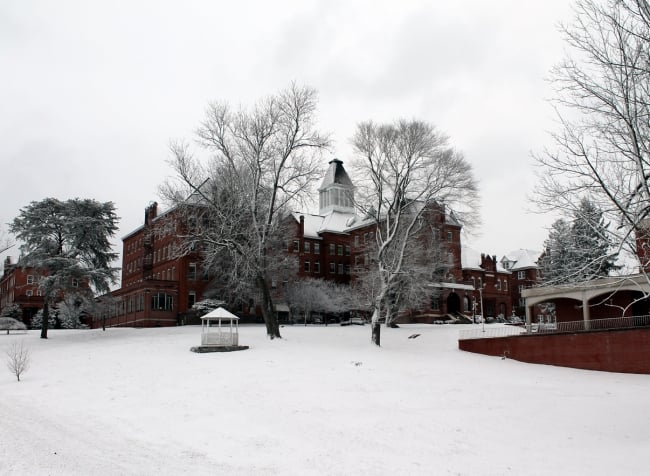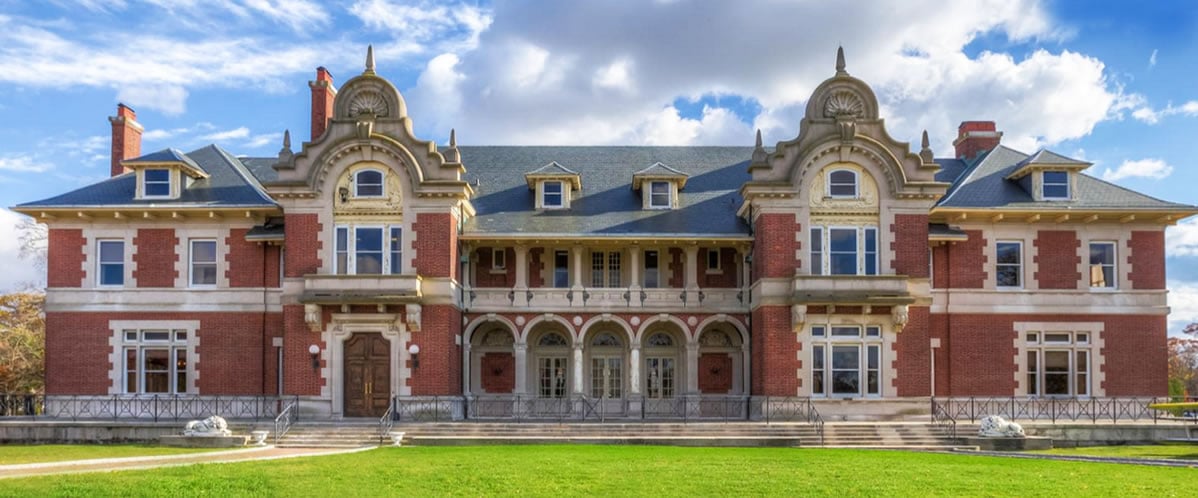You have /5 articles left.
Sign up for a free account or log in.

Virginia Intermont's campus recently sold, another step in a long wind down after the college's closing in 2014.
Virginia Intermont
Virginia Intermont College graduated its final class in early May 2014, holding commencement on a clear Sunday afternoon.
Despite the sun shining, one faculty member who spoke at the ceremony likened it to a funeral. The 130-year-old college in Southwestern Virginia had been on life support for years as financial troubles fueled accreditation issues. Yet faculty and students still describe a disorganized whirlwind once it finally became clear that spring that the college would be closing.
If the May commencement ceremony was a de facto funeral for Virginia Intermont, the next 27 months became a protracted winding down of the college’s estate. Student records needed to be transferred to another college for safekeeping. Virginia Intermont’s well-known equestrian program needed to be moved to another institution. Items like office supplies, dorm furniture and window air conditioners waited to be sold.
The most visible element of the winding down -- selling Virginia Intermont’s 20-acre campus -- dragged on until December 2016. In the middle of the month, Highlands Union Bank took the property to a foreclosure auction. It sold for $3.3 million to a Chinese company planning to use it for a four-year college.
That’s not enough to cover Virginia Intermont’s debts. The college owed roughly $4 million to two banks. It owed about $6 million in other bills, which included salaries for employees who worked without pay for months before the college closed.
The case highlights just how hard it can be to shut down a college or university -- even a small institution like Virginia Intermont, which had 378 students in the fall of its last year, down from 586 three years earlier. Faculty, staff, students and alumni are all upended. But complicated and often overlooked steps also need to be taken to try to pay off creditors, transfer endowments, inform regulators and sell assets.
While college closures are not unheard-of, they’re also far from common. As a result, presidents and trustees can be uncertain how to proceed.
“These situations are so unusual and so rare,” said Robert Lambeth, president of the Council of Independent Colleges in Virginia. “The kinds of people who serve as board members are probably the kinds of people who would not have encountered these situations in their normal business dealings. There are certainly things that are learned, and it’s much more complicated than I think anyone would have thought.”
Lambeth has found himself with a front-row seat to several college closings of late. Before Virginia Intermont in 2014, there was Saint Paul’s College, a historically black college in Lawrenceville, Va., which lost its accreditation in 2012 amid issues including a lack of financial stability and then shut down the next year. Then there was Sweet Briar College.
Administrators and trustees moved to shut down the all-women’s Sweet Briar, located north of Lynchburg, Va., in 2015 because of heavy tuition discounting and enrollment challenges. But Sweet Briar didn’t face the same immediate financial cliff as its less fortunate peers, and its alumnae base proved to be extremely vocal and effectively organized. Alumnae mobilized to support the college, and it controversially continued operations under new leadership.
When colleges and universities are under the heavy strains that can lead to closure, they face both human and legal challenges. Lambeth thinks of the leaders involved.
“It’s extremely stressful, and it’s personally challenging,” he said. “I’ve known these presidents for years, and I’ve watched them. Literally, the president is on the phone all night trying to raise enough money to meet payroll or even keep the electricity from being turned off.”
Dowling College Files for Bankruptcy
Of course, Virginia is not the only state where college closures have taken place. The 2,000-student Dowling College on New York’s Long Island shut down this summer due to financial problems after attempts to find a partner institution collapsed. Dowling filed for Chapter 11 bankruptcy protection at the end of November, a precursor to selling its real estate and other assets in order to try to pay off creditors.
Some colleges, including Virginia Intermont and Sweet Briar, don’t file for bankruptcy protection when closing -- state laws can sketch out a process for dissolving institutions. But the circumstances merited it in Dowling’s case, said Sean Southard, a lawyer for Dowling who is partner at Klestadt Winters Jureller Southard & Stevens LLP in New York City.
“Ultimately, Chapter 11 was chosen by Dowling and its major constituents because it was viewed as the best means of efficiently selling these assets in a way that would give buyers comfort that they’re getting very clean assets because of the ability of the bankruptcy court to convey titles free and clear of liens and claims,” Southard said.
Dowling faces hundreds of creditors, according to court records. As of Dec. 29, a claims agent registry listed 652 filed and scheduled claims totaling more than $70 million, including contingent, unliquidated and disputed claims. Secured claims totaled nearly $61.5 million. Wilmington Trust held the largest individual claim, $37.3 million for bonds. Other large creditors included UMB Bank, also for bonds, and the U.S. Department of Education, for Title IV funds. Some employees and faculty members also claimed unpaid compensation.
 The college estimated its assets as being worth just under $109 million, with nearly all of the value coming from real estate. Dowling listed 38 properties as assets. Most notably, its Oakdale campus -- with includes the Vanderbilt mansion pictured at right -- was valued at $52.3 million, and its Brookhaven campus was valued at $42.7 million.
The college estimated its assets as being worth just under $109 million, with nearly all of the value coming from real estate. Dowling listed 38 properties as assets. Most notably, its Oakdale campus -- with includes the Vanderbilt mansion pictured at right -- was valued at $52.3 million, and its Brookhaven campus was valued at $42.7 million.
Dowling’s bankruptcy court documents clearly demonstrate that a college closure can be as financially complex as the shutdown of any other large organization. Notes on its bankruptcy statements detail issues including a levied bank account, restrictions on endowment funds, unpaid claims under a terminated health insurance plan for employees and an early retirement program offered in 2015 that was to be paid out over four years.
Endowments in particular add a special set of complications. College and university endowments are not single pots of money -- they’re made up of numerous smaller funds that are often restricted for specific purposes outlined by donors. When an institution shuts down, the endowment dollars it holds typically need to be transferred to another charitable institution.
Sifting through different endowment funds can be a painstaking and expensive process, once legal fees are tallied. Restrictions can be released or modified if a donor consents. If donors are dead or can’t be contacted, modifications can be put in place if a court agrees that they align with a donor’s likely intention. A state’s chief charitable regulator -- typically its attorney general -- can take part in those cases, objecting to modifications if they deem it necessary.
The modification process has become easier in the last decade, during which nearly every state has adopted a version of the Uniform Prudent Management of Institutional Funds Act, known as UPMIFA. Much of UPMIFA deals with managing and spending from endowments, but it also includes provisions making it easier to modify restrictions on small and old funds without going to court.
Still, transferring or redirecting endowed funds involves a patchwork of oversight and discussion with donors and constituencies, said Barry C. Hawkins, a partner at Shipman & Goodwin LLP in Stamford, Conn., and Uniform Law commissioner who chaired the UPMIFA drafting and enactment committees. Federal tax policy is involved because endowments are established through tax-free donations. Donors, courts and state charity regulators all have a hand in the process.
“UPMIFA reinforces and gives some flexibility to the repurposing and redirection of these funds, but it still needs to be blessed by the probate court or the attorney general in a wind down,” Hawkins said. “The funds need to be used for charitable purposes.”
Endowment funds’ designation for charitable purposes can lead to conflict if an institution’s creditors see endowments as a pot of money to claim instead of a restricted class of assets.
“When institutions are winding down, they’re also in financial trouble and you’ve got creditors circling,” Hawkins said. “That’s where the action has been in the last 15 years -- to understand these are segregated funds for a charitable purpose.”
Those handling Dowling’s wind down say they’re still evaluating the college’s endowment, which consists of about 55 individual funds previously estimated to total $2 million. It’s an ongoing process to work with New York’s attorney general and evaluate restrictions, said Robert Rosenfeld, Dowling’s chief restructuring officer and managing director of corporate restructuring firm RSR Consulting.
Beyond the endowment, Dowling’s bankruptcy filing puts a wind-down process in place, Rosenfeld said. The bankruptcy code spells out which creditors get paid first.
“I’ve been chief restructuring officer in a lot of cases,” he said. “I am a Chapter 7 trustee. I’m not a lawyer, but I’ve seen all parts of bankruptcy. And a lot of them -- most cases -- are similar, because you still have to abide by the code and the law.”
One other detail that stands out to Rosenfeld about Dowling is that students are involved.
Student records have to be maintained so students who earned degrees or credit can apply to graduate school or another college. In Dowling’s case, the records are being transferred and managed by Long Island University, Rosenfeld said.
Colleges have reason to try to avoid the bankruptcy code, however -- filing for bankruptcy kills federal financial aid funding.
“As a going concern and operating school that is dependent upon Title IV financing, you cannot file a bankruptcy if you intend to restructure or turn around,” said Southard, Dowling’s lawyer. “What happens is that Title IV funding is pulled immediately. In essence, you come to a screeching halt.”
Sweet Briar Reboots
 Sweet Briar did not file for bankruptcy protection when officials decided to close the college in 2015. But the college had essentially brought its operations to a halt by the time alumnae won their fight to keep the institution open under a new administration, so it remains an important case to study in the shuttering of colleges.
Sweet Briar did not file for bankruptcy protection when officials decided to close the college in 2015. But the college had essentially brought its operations to a halt by the time alumnae won their fight to keep the institution open under a new administration, so it remains an important case to study in the shuttering of colleges.
The Sweet Briar case has been repeatedly cited as a success story, a win for supporters of small, private liberal arts colleges fighting back against forces conspiring to wipe out such institutions. Yet the jury is still out in many ways as to whether that is true.
Sweet Briar’s total enrollment this fall grew to 329, up from 245 last year. It was able to pay down $2.5 million in bond debt after tight financial discipline and a major fund-raising push allowed the college to avoid drawing on its endowment to fund operations last year. But enrollment remains more than 200 students below 2014-15 levels. President Phillip Stone thinks the college will need to grow to 800 students, then consider building additional capacity in order to establish economies of scale. Bond debt still stands at $22 million.
Regardless of whether Sweet Briar continues operating indefinitely, the proactive decision-making process behind its attempted closure stands in stark contrast to the way other institutions have slowly been crushed by declining enrollments and debts. Sweet Briar’s near-death experience also gives Stone some insight into the cost of closing a college.
“It is frankly a classic case, a sterling case of how to close if you really need to,” said Stone, who was brought in to oversee Sweet Briar as it restarted operations. Stone now plans to retire in the summer of 2017, when he will be 75.
All of Sweet Briar’s bills would have been paid while professors and employees would have received their wages -- and possibly severance as well. The idea behind the closure was to pay off bond debt, severance and other expenses while the institution still had available financial resources -- instead of after it had passed the point of no return.
When Sweet Briar officials decided to close the college, they announced their plans in March 2015. That gave them time to transfer critical operations like a study abroad program and to contact state and federal regulators, banks, accreditors, and academic consortia, Stone said.
Sweet Briar officials spelled out a plan that included on-campus college fairs to help current students transfer. They discussed outplacement services for staff and faculty members.
The potential for a smooth shutdown process was never realized because of the fight over the closure decision, however. The college’s leaders at the time said they faced financial pressures despite an endowment of more than $80 million -- much of which was restricted. They added that the college had tallied $28 million in deferred maintenance that needed to be performed, as well as debts of roughly the same amount.
Plus, they said student interest in rural institutions and in women’s colleges was dropping.
“The liberal arts college sector is embattled now on so many different fronts,” then President James F. Jones Jr. said at the time.
Advocates won a deal to keep the college open in late June 2015. But the shutdown process had already begun, and it was expensive. Severance payments alone cost $5 million, Stone said.
Given the expense involved, Stone acknowledged the reasoning behind the decision to shut down the college. Sweet Briar still needs to develop financial stability and stake out its future in the midst of a declining pool of students attending single-sex liberal arts colleges, he said.
“The board that closed looked at factors that are legitimate,” Stone said. “We can’t wish those away. Those are not fabricated. Those are real issues.”
Still, he believes there has to be a middle ground between closing too early and too late.
“Going out ugly is not nice,” Stone said. “You don’t want that as what people remember. Somewhere between closing without doing all that you can do to stay open and getting to the place where it’s sad to see how you go out, there has got to be an opportunity for creativity and initiative.”
Virginia Intermont Slowly Dies
The idea of going out ugly is likely to spark discussion of Virginia Intermont. Financial troubles at the college were no secret in the years leading up to its closure. Such issues led to accreditation trouble, with the college seeking an injunction against the Southern Association of Colleges and Schools Commission on Colleges in 2013 in an attempt to stave off its accreditation being revoked.
In 2014, the situation came to a head. The college was to lose its accreditation July 1 of that year. Plans to merge with Webber International University collapsed.
By April, the situation had reached a critical point on campus. Virginia Intermont was threatened with having its electricity shut off if it did not pay its bill. The college struggled and failed to cut checks for employees on time. At one point, the college briefly posted an appeal for donations totaling $291,000 -- including $106,000 for payroll and $100,000 for student refunds. E. Clorisa Phillips, at the time the president, sent an extraordinary email statement at the end of the month acknowledging that the college was not sure it would have utility service the next week and that it was attempting to answer questions about possible layoffs.
“Please know that, together, the trustees, the cabinet and I have been working as hard as we can to find funding for the past and current payrolls,” Phillips wrote, according to the Bristol Herald Courier. “We are also trying to answer questions such as who will be laid off and when, if there will be power and utilities next week, and whether the college can pay the May health care premium by May 9. These questions are complicated by various legal matters and, thus, the answers are hard to produce. I know this much right now: we will not be paid today.”
Virginia Intermont officials explored selling musical archives from the late country singer “Tennessee Ernie” Ford to a high bidder. But the Ford family objected, pointing out that an agreement prevented the archives from being sold or transferred without the Ford estate’s approval.
Many saw Virginia Intermont's leadership as paralyzed, even after administrators announced their merger plans had fallen through and that students would have teach-out options.
“I felt like it was kind of chaos,” said Athena Demas, who had to enroll at Emory & Henry College for one semester after Virginia Intermont closed in order to finish her undergraduate degree in history and political science. “The students didn’t really know what to do because the administration didn’t really communicate with us. There was no transparency.”
Five institutions reached teach-out agreements for Virginia Intermont students. About 150 students decided to take part in the program. But students reported difficulty obtaining information from the college about their teach-out options. Others raised issues with student loan refunds.
Some professors reported not being paid for months. Some said money deducted from their paychecks for health insurance and retirement accounts was not ending up in those accounts. Retirees reported insurance policies canceled because the college hadn’t paid for them.
Faculty voted no confidence in Phillips in mid-April. When the college held its commencement, faculty President Robert Rainwater described feelings of “profound unhappiness” at the closing of the college.
“Institutions don’t have funerals, but it is as if we’ve experienced the death of a family of people we love,” said Rainwater, a former Virginia Intermont interim president, according to the Herald Courier. “We can’t leave without acknowledging those crucial facts.”
He also lashed out at the college’s leadership.
“It was not preordained that VI must close,” he said, according to the newspaper. “Intermont could have survived. Things could have worked out otherwise, but we followed our leadership and it led to complete institutional failure. As a result, the school we love is coming to an end.”
Faculty members who had stayed with the institution even though they weren’t being paid said they kept working out of a sense of duty.
“We had a stake in it,” said Edison Jennings, who was an associate professor of English literature and rhetoric. “We stayed on to finish the academic year and to get the graduates out the door and to get the undergraduates transferred.”
It wasn’t just faculty members, Jennings said. Staff members stayed on even after receiving paychecks that bounced.
Jennings said he never received two months’ worth of pay he is owed for work at the end of the college’s operations. Other former faculty members and employees reported similar experiences.
At the moment, though, the college's $3.3 million sale price doesn't look like enough to cover salaries. It was roughly a fifth of the $15 million asking price listed when the campus first went up for sale in 2014. The auction in which the campus sold took less than 90 seconds, according to the Herald Courier.
The bidding meant Virginia Intermont still owes millions to other businesses and former employees. Interim President Art Rebrovick told the Herald Courier that debt would likely go unpaid.
“I don’t see any chance for anyone else to get paid, which is very unfortunate,” he said, adding that he thought the bank moved too quickly to foreclose. He said two other parties had submitted higher bids. Rebrovick did not respond to requests for comment from Inside Higher Ed.
Virginia Intermont’s primary creditor earlier rejected a bid that would have had a buyer of the campus setting up a health care services business. Highlands Union Bank decided to take the property to the public foreclosure sale instead.
Bluefield College had also been interested in the campus as a location for an engineering program and for science and technology classes. But it reportedly found about $20 million in deferred maintenance on buildings.
A Chinese group, U.S. Magis International Education Center, submitted the winning bid for the campus. It intends to set up a four-year college.
The Herald Courier quoted a representative of the group, George Xu, as saying the site will be the group’s first college in the United States.
“Right after getting the property, we will apply for accreditation. Once we get the accreditation, then we can start,” Xu said. “When we get the accreditation and the school opens, we are going to hire back some of the faculty, and it is going to be a four-year college again. We may add some more [courses] depending on the needs of the community, probably some science and engineering; maybe some Chinese medicine.”
The human ramifications of Virginia Intermont’s closing continue to play out. Some former students are still trying to make sense of the college’s end days. Radvile Autukaite was a junior studying business management when the institution closed. She was also the president of the Student Government Association.
“Everybody tried,” Autukaite said of attempts to keep Virginia Intermont open and the subsequent scramble to wind down operations. “I don't think there was one person that didn’t want to do it. I just think from a business perspective, it didn’t make sense. That’s why, I think, it was such a late process -- everybody to the last minute was trying to make it work.”
Some still haven’t reached conclusions about the college’s closing and the difficult semesters leading up to it. Tiffany Vu graduated from Virginia Intermont in December 2013 but was Student Government Association president in her junior year, a position that exposed her to many of the financial difficulties and associated power struggles playing out at the time. She searches for news on the college to this day.
“I am constantly trying to see what’s going on,” Vu said. “You see the school is on sale for $15 million, and the next thing you know the school just got sold for $3.3 million, and you see all the decisions the bank made or the Board of Trustees made, and it’s like, ‘What were you people doing?’ It’s really sad. I see it all the time, and I know it impacts the people I care about.”




